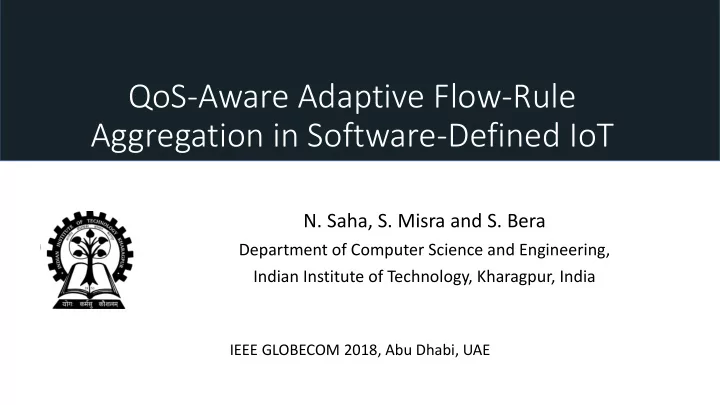

QoS-Aware Adaptive Flow-Rule Aggregation in Software-Defined IoT N. Saha, S. Misra and S. Bera Department of Computer Science and Engineering, Indian Institute of Technology, Kharagpur, India IEEE GLOBECOM 2018, Abu Dhabi, UAE
Problem Statement SDN utilizes the OpenFlow protocol for rule-based data-plane operations. Flow-rules are in the form of match-action pairs, with each rule capable of matching on multiple fields such as ingress port, vlan id, ethernet, and tcp header fields. TCAM memory in OpenFlow switches is limited. Flow-table overflow due to exact-match rules Fine-grained QoS forwarding uses exact-match rules. There is a need to address the flow-table overflow problem N. Saha, S. Misra and S. Bera, Indian Institute of Technology, Kharagpur QoS-Aware Adaptive Flow-Rule Aggregation in Software-Defined IoT
Problem Statement (cont.) Heterogeneous IoT connected to SDN-enabled backbone by SDIoT gateways. Flow-rule 𝑠 𝑘 = 𝑁 𝑘 , 𝐵 𝑘 , 𝐷 𝑘 𝑁 𝑘 -> match fields 𝐵 𝑘 -> action set 𝐷 𝑘 -> counters Flow table at switch 𝑡 𝑗 is given as 𝑗 | 1 ≤ 𝑘 ≤ 𝑆 𝑛𝑏𝑦 𝑆 𝑗 = 𝑠 𝑘 System Architecture IoT flows require application specific QoS treatment. Fine grained QoS forwarding using exact-match rules lead to rule-overflow. Aggregating the flow-rules using a combination of source and destination port i.e., (s1, ∗ , ∗ , dp1) is capable of correctly forwarding the IoT flows under consideration. N. Saha, S. Misra and S. Bera, Indian Institute of Technology, Kharagpur QoS-Aware Adaptive Flow-Rule Aggregation in Software-Defined IoT
Problem Statement (cont.) Rifai et al. (IEEE GLOBECOM 2015). At s1, the correct Kosugiyama et al . (IEEE ICC2017). Packet-in output action for flows from s1 with dst port dp1 is messages are generated for flows f1 and f3 due to out port 1. However, due to the (s1, ∗ , ∗ , ∗ ) rule, f4 is table-miss. However, flow f2 matches the aggregated flow rule (s1, ∗ , ∗ , ∗ ) and is forwarded forwarded incorrectly out port 2. incorrectly out port 2, before generation of packet-in message. N. Saha, S. Misra and S. Bera, Indian Institute of Technology, Kharagpur QoS-Aware Adaptive Flow-Rule Aggregation in Software-Defined IoT
Adaptive Flow-Rule Aggregation Need to choose from multiple candidate paths. Flow-table overflow at bottleneck switch invalidates all paths through that switch. Given a set of paths, choose the path P with minimum cost 𝜀 𝑄 . The cost of The greedy approach chooses path f1 with three choosing a path P is given as new flow-rule insertions at s2, s3 and s6. The Best- |𝑆 𝑗 | 𝛽 + 𝛾 max 𝜀 𝑄 = fit heuristic takes into account the bottleneck 𝑆 𝑛𝑏𝑦 𝑗 switch, s3, and chooses path f10 with four new 𝑡 𝑗 where represents the cost of inserting flow-rule insertions at s2, s4, s5 and s6. a new flow- rule and α, β are normalizing constants. N. Saha, S. Misra and S. Bera, Indian Institute of Technology, Kharagpur QoS-Aware Adaptive Flow-Rule Aggregation in Software-Defined IoT
Solution Approach N. Saha, S. Misra and S. Bera, Indian Institute of Technology, Kharagpur QoS-Aware Adaptive Flow-Rule Aggregation in Software-Defined IoT
Performance Evaluation Average end-to-end delay Average packet-loss With 300 flows in the network, the proposed scheme reduces the average delay by 35% and 70% and packet loss by 10% and 12% compared to Agg-Delay and Exact-match, respectively. Exact-match suffers due to the effect of flow-setup delay for every flow. Agg-Delay incurs more loss due to wrong forwarding decisions. N. Saha, S. Misra and S. Bera, Indian Institute of Technology, Kharagpur QoS-Aware Adaptive Flow-Rule Aggregation in Software-Defined IoT
Performance Evaluation (cont.) Reduction in flow rules Average throughput The proposed scheme incurs 20%and 110% increase in throughput compared to Agg- Delay and Exact-match, respectively. The Best-fit heuristic leads to a more uniform distribution of flow-rules across the network. N. Saha, S. Misra and S. Bera, Indian Institute of Technology, Kharagpur QoS-Aware Adaptive Flow-Rule Aggregation in Software-Defined IoT
Current Work in Progress • OpenFlow 1.5 specification supports upto 44 header fields. • If more number of match-fields are considered, QoS violations will decrease at the cost of increase in the flow-table size. • Which one of the k -combinations will lead to optimal trade-off between number of flow-rules number The proposed scheme consists of three components: of QoS-violated flows? • Key-based aggregation scheme capable of fast flow-rule aggregation. • Multi-arm bandit (MAB)-based scheme for selecting the best key. • Best-fit heuristic to maximize the total number of flow-rules that can be placed in the network. N. Saha, S. Misra and S. Bera, Indian Institute of Technology, Kharagpur QoS-Aware Adaptive Flow-Rule Aggregation in Software-Defined IoT
THANK YOU N. Saha, S. Misra and S. Bera, Indian Institute of Technology, Kharagpur QoS-Aware Adaptive Flow-Rule Aggregation in Software-Defined IoT
Recommend
More recommend